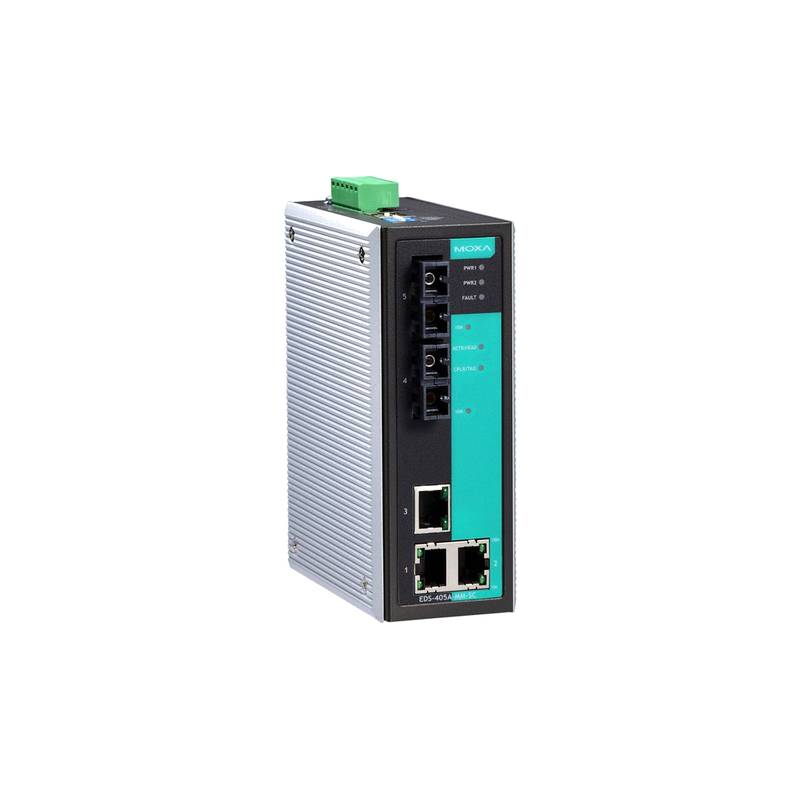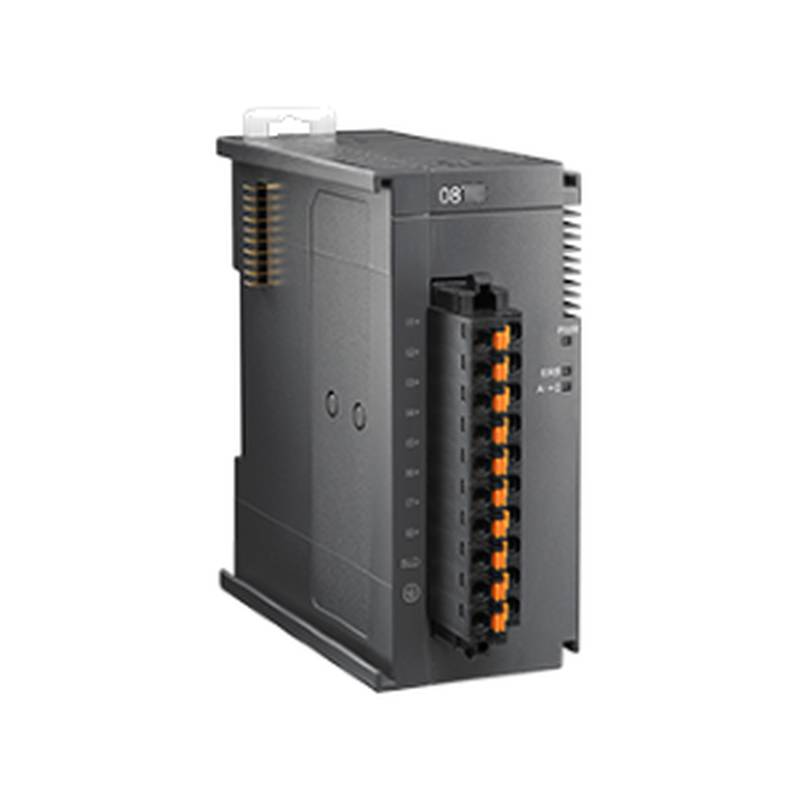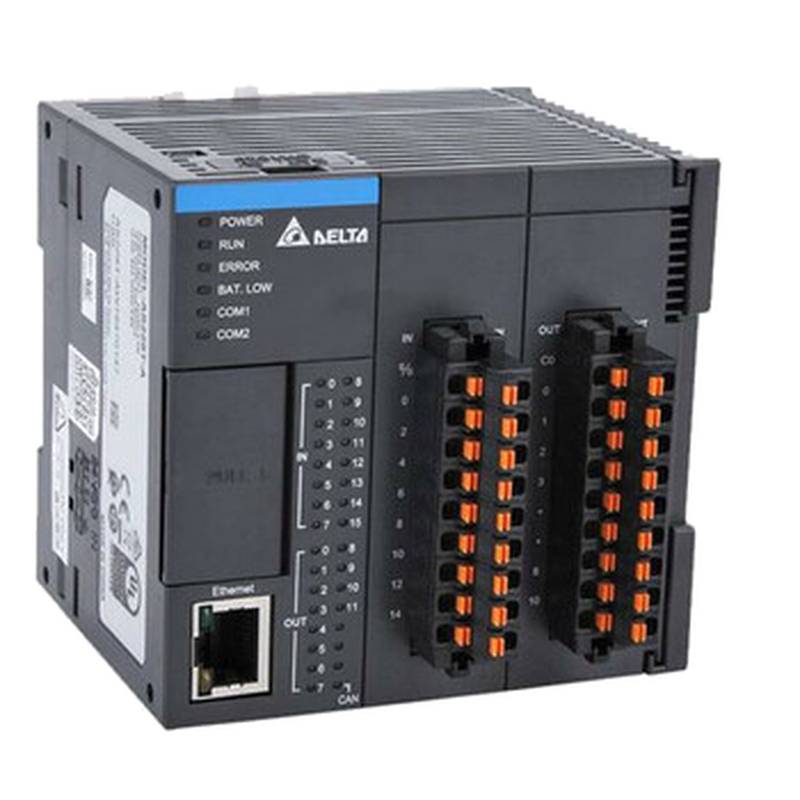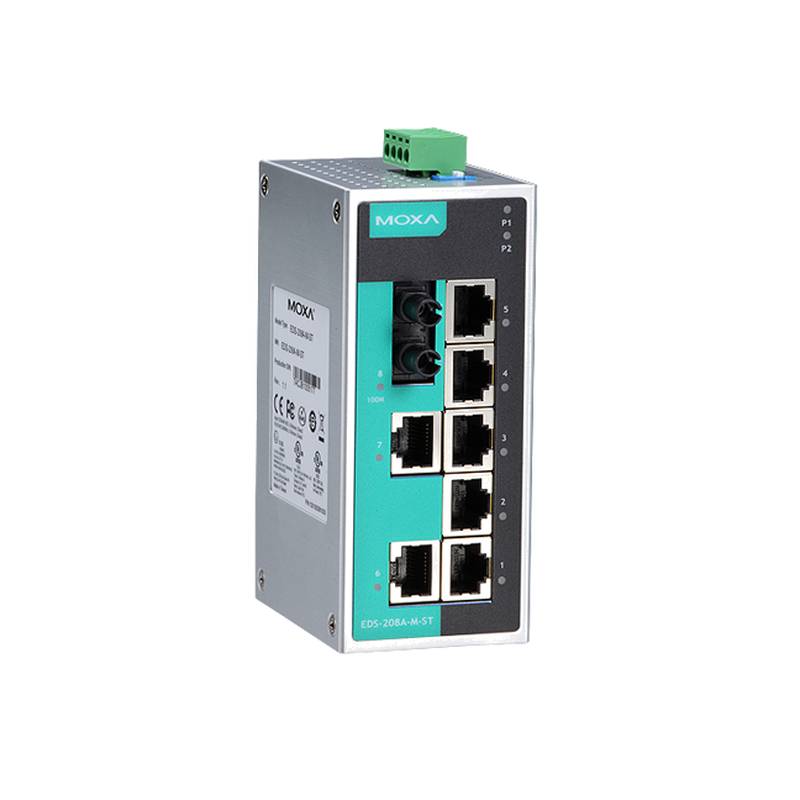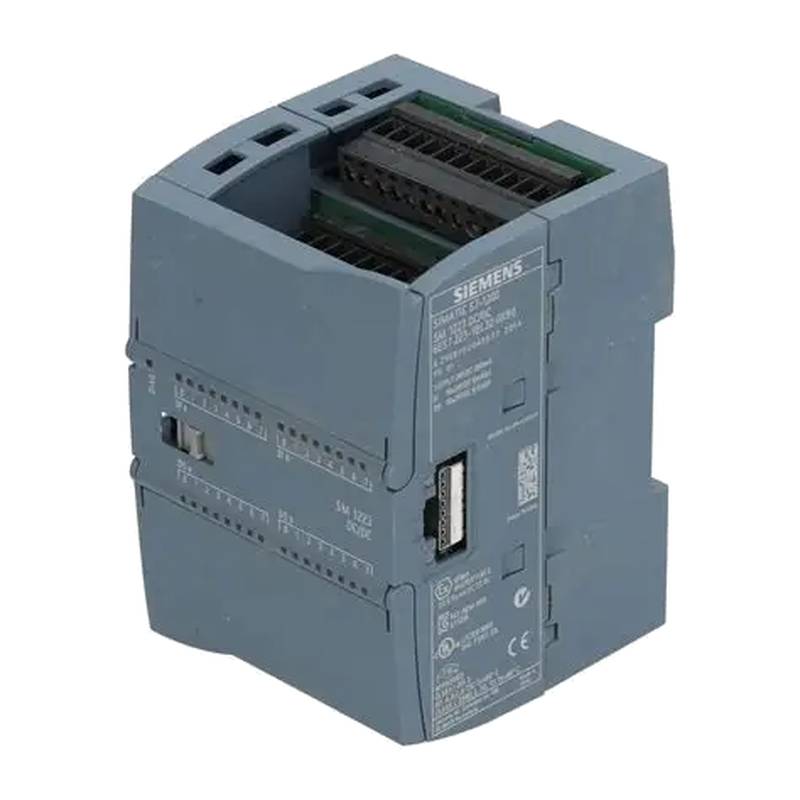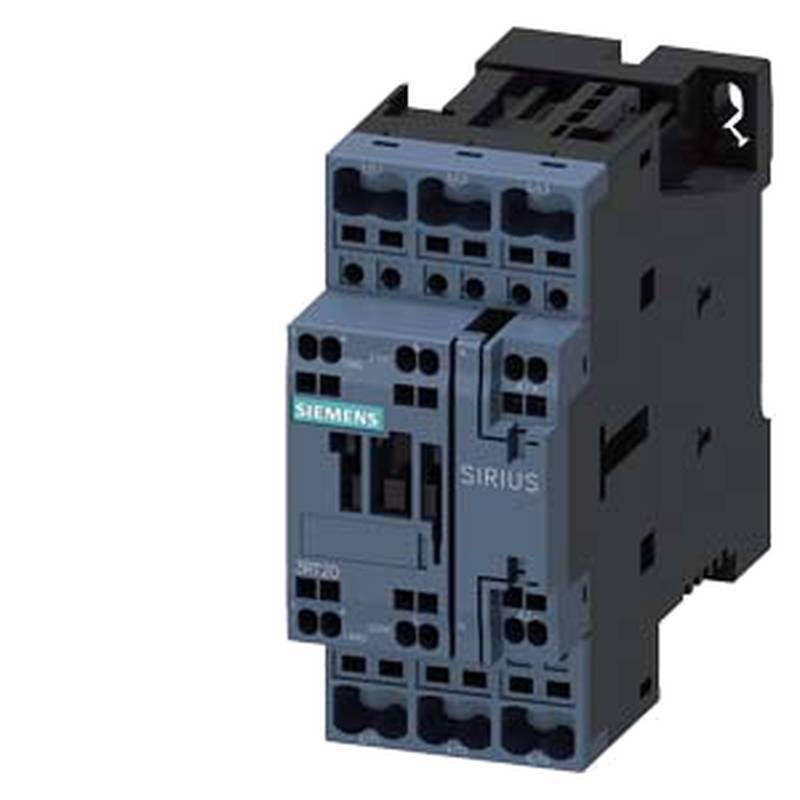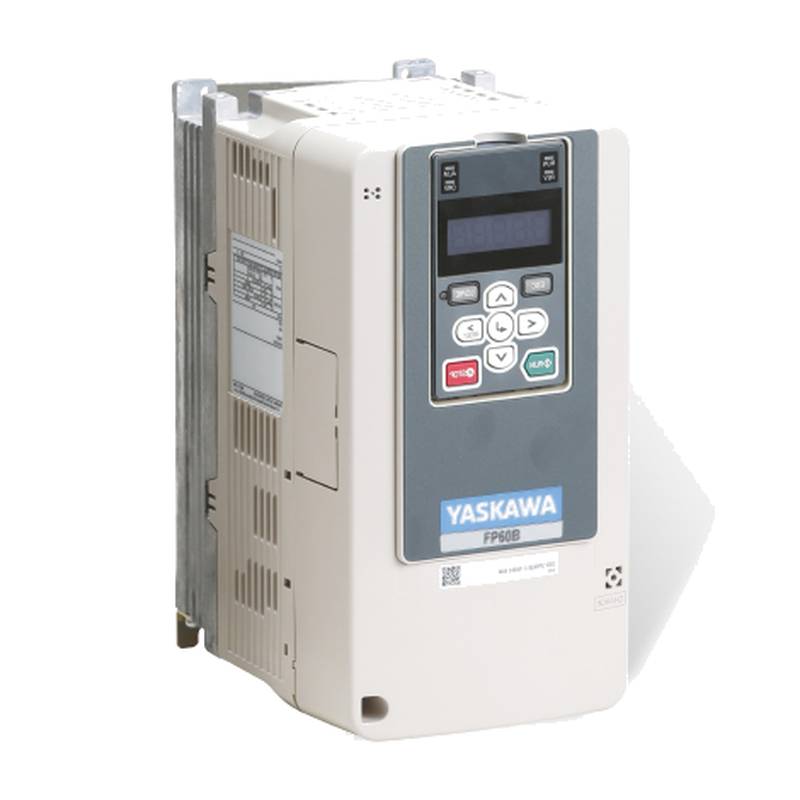
The Moxa EDS-405A-SS-SC is a robust 5-port industrial Ethernet switch engineered for demanding environments, featuring single-mode SC fiber connectivity for extended network reach. Its critical advantages lie in its rugged design, reliable operation in extreme temperatures, and support for critical industrial protocols, making it an ideal choice for applications requiring high availability and long-distance data transmission. Key technical specifications include a wide operating temperature range of -40 to 75°C, dual redundant power inputs (12/24/48 VDC), and a DIN-rail mounting design for easy industrial panel integration. The switch boasts a compact form factor and supports 10/100BaseT(X) Ethernet ports alongside its single-mode SC fiber optic uplink, ensuring seamless connectivity across diverse industrial networks.
Product Specifications
| Feature | Specification |
| :---------------------- | :------------------------------------------------- |
| Model | Moxa EDS-405A-SS-SC |
| Ethernet Ports | 4 x 10/100BaseT(X) RJ45 |
| Fiber Port | 1 x 100BaseFX Single-mode SC |
| Fiber Distance | Up to 30 km |
| Power Input | Dual Redundant 12/24/48 VDC |
| Operating Temperature | -40 to 75°C |
| Mounting | DIN-rail |
| Protocol Support | IEEE 802.3, 802.3u, 802.3x, 802.1D, 802.1p, 802.1w |
| Mean Time Between Failures (MTBF) | 500,000+ hours (typically) |
| Dimensions | 31.5 x 135 x 95 mm |
Core Features & Market Positioning
The Moxa EDS-405A-SS-SC distinguishes itself in the industrial networking market through its exceptional reliability and purpose-built design for harsh operational conditions. Its primary competitive advantage is the integration of single-mode SC fiber optic connectivity, which dramatically extends Ethernet network reach far beyond the limitations of copper cabling, crucial for sprawling industrial sites, pipeline monitoring, or transportation infrastructure. This capability, combined with its wide operating temperature range and dual power inputs, positions it as a dependable solution where network uptime is paramount and environmental factors are challenging. Moxa's reputation for industrial-grade hardware further bolsters its market standing, assuring users of long-term performance and stability in mission-critical applications.
Key Application Scenarios
This industrial fiber switch is exceptionally well-suited for applications demanding extended network reach and high reliability. It is commonly deployed in Supervisory Control and Data Acquisition (SCADA) systems for remote monitoring and control of substations in the power and utility sectors, leveraging its fiber optic uplink to bridge significant distances between control centers and field equipment. In the oil and gas industry, the EDS-405A-SS-SC facilitates robust communication networks across vast processing plants and remote exploration sites, ensuring data integrity even in hazardous environments. Furthermore, its resilience makes it a prime candidate for intelligent transportation systems (ITS), connecting traffic management devices, surveillance cameras, and sensors along highways and within urban networks over long fiber optic runs.
Practical System Integration Guidance
Integrating the Moxa EDS-405A-SS-SC into an existing industrial network is straightforward due to its plug-and-play nature for basic connectivity. Installation typically involves mounting the switch onto a standard DIN-rail within an industrial control cabinet. Power is supplied via its dual terminal blocks, allowing for redundant power sources to enhance system availability; wiring requires connecting the positive and negative terminals for each power input. For the Ethernet ports, standard Cat5e or higher Ethernet cables are used to connect to field devices or upstream network equipment. The single-mode SC fiber port connects to other fiber-enabled network devices or transceivers using single-mode fiber optic patch cords, ensuring correct polarity and clean connector mating for optimal signal integrity. Configuration, if required for advanced features like VLANs or QoS, can be accessed via a web interface or console port, often using Moxa's embedded device management tools.
Operation and Risk Mitigation
Operating the Moxa EDS-405A-SS-SC involves ensuring proper power supply and physical connections to maintain continuous operation. A key risk mitigation strategy is utilizing the dual redundant power inputs, connecting two separate DC power sources to prevent network downtime in case of a single power supply failure. Regular inspection of fiber optic connections for cleanliness and physical integrity is crucial to prevent signal degradation or loss, especially in dusty or vibration-prone environments. While the EDS-405A-SS-SC is designed for high reliability, potential troubleshooting steps for connectivity issues often involve verifying IP address configurations, checking link lights on both the switch and connected devices, and inspecting physical cabling. For fiber optic links, using a visual fault locator can help identify breaks or severe bends in the cable. The switch's robust design inherently minimizes risks associated with extreme temperatures and electromagnetic interference common in industrial settings.
Scalability & Long-Term Value
The Moxa EDS-405A-SS-SC offers significant long-term value through its inherent scalability and compatibility with emerging industrial communication standards. Its ability to serve as a high-speed backbone for copper-based networks, via its fiber optic uplink, allows for the expansion of network reach without costly replacements of existing field devices. This is particularly relevant as industries transition towards Industry 4.0 and the Industrial Internet of Things (IIoT), where greater sensor density and remote data acquisition are required. The switch's support for standard Ethernet protocols ensures compatibility with a wide range of industrial automation components and controllers. Furthermore, its rugged build quality and Moxa's commitment to product lifecycle support mean the EDS-405A-SS-SC can remain a reliable network asset for many years, reducing the total cost of ownership and providing a stable platform for future network upgrades and integrations.
Frequently Asked Questions
What are the primary benefits of using the Moxa EDS-405A-SS-SC switch?
The Moxa EDS-405A-SS-SC offers extended network reach due to its single-mode SC fiber port. This allows for reliable data transmission over distances up to 30 km. It is built for harsh industrial environments, supporting a wide operating temperature range.
This industrial switch features dual redundant power inputs, enhancing network uptime and resilience against power supply failures. Its rugged construction ensures dependable operation in demanding conditions. The device is designed for easy DIN-rail mounting in industrial cabinets.
Key advantages also include its support for essential industrial Ethernet protocols, ensuring interoperability. The switch provides robust performance for SCADA, IIoT, and critical infrastructure applications. It offers a cost-effective solution for long-distance industrial networking needs.
How does the single-mode SC fiber port on the EDS-405A-SS-SC differ from multi-mode fiber?
Single-mode fiber (SMF) uses a smaller core diameter, typically 9 micrometers, which supports a single light path. This significantly reduces signal dispersion and attenuation, enabling much longer transmission distances, up to 30 km for this switch.
Multi-mode fiber (MMF) has a larger core diameter, usually 50 or 62.5 micrometers, allowing multiple light paths. While easier to couple light into, MMF experiences higher modal dispersion, limiting its effective range to a few kilometers at most.
Therefore, the single-mode SC port on the EDS-405A-SS-SC is specifically chosen for applications requiring long-haul connectivity, unlike multi-mode which is better suited for shorter distances within a facility.
What are the power requirements and redundancy features of this industrial switch?
The Moxa EDS-405A-SS-SC supports dual redundant power inputs, accepting a wide DC voltage range from 12 to 48 VDC. This feature is critical for industrial applications where network continuity is paramount.
By connecting two separate power sources to the respective input terminals, the switch automatically switches to the backup source if the primary fails. This redundancy ensures uninterrupted operation of the network.
The wide voltage range allows flexibility in selecting power supplies commonly available in industrial settings, simplifying installation and maintenance while enhancing overall system reliability.
Can the Moxa EDS-405A-SS-SC be used in extremely cold or hot environments?
Yes, the Moxa EDS-405A-SS-SC is specifically designed for industrial environments with extreme temperature variations. It operates reliably within a wide temperature range of -40 to 75°C (-40 to 167°F).
This broad operational temperature capability makes it suitable for deployment in outdoor enclosures, unheated facilities, or areas with significant thermal fluctuations common in sectors like oil and gas or renewable energy.
Its robust design ensures that critical network connectivity remains stable and operational regardless of external ambient temperature extremes.
What types of industrial protocols does the EDS-405A-SS-SC support?
The switch adheres to fundamental IEEE Ethernet standards such as IEEE 802.3 for Ethernet, IEEE 802.3u for Fast Ethernet, and IEEE 802.3x for flow control. This ensures basic network functionality and compatibility.
It also supports IEEE 802.1D for Spanning Tree Protocol (STP) and IEEE 802.1w for Rapid Spanning Tree Protocol (RSTP). These protocols are essential for creating loop-free networks and ensuring redundancy.
Additionally, support for IEEE 802.1p provides Quality of Service (QoS) capabilities, allowing prioritization of critical traffic, which is vital for real-time industrial data.
How is the Moxa EDS-405A-SS-SC typically installed in an industrial setting?
The EDS-405A-SS-SC is designed for easy and secure mounting onto a standard 35 mm DIN-rail, a common fixture in industrial control panels and enclosures. This allows for quick integration into existing or new electrical cabinets.
Installation involves connecting the Ethernet cables to the RJ45 ports for local devices and the SC fiber port for long-distance links. The dual power terminal blocks require connection to appropriate DC power sources for operation.
Once physically installed and powered, the switch can be configured through its web interface or command-line interface for advanced network settings if required.
What is the typical Mean Time Between Failures (MTBF) for this switch?
The Moxa EDS-405A-SS-SC is engineered for high reliability, with a typical Mean Time Between Failures (MTBF) exceeding 500,000 hours. This metric indicates the average operational time expected before a component failure.
This high MTBF value is a testament to the robust component selection and rigorous testing Moxa applies to its industrial-grade products. It signifies a very low probability of failure during its operational lifespan.
Achieving such a high MTBF is crucial for mission-critical industrial networks where unscheduled downtime can result in significant financial losses and safety risks.
What are the advantages of using fiber optic ports over copper Ethernet in industrial applications?
Fiber optic ports, like the single-mode SC on this switch, offer immunity to electromagnetic interference (EMI) and radio frequency interference (RFI). This is a significant advantage in noisy industrial environments with heavy machinery or high-voltage equipment.
Fiber optic cables can transmit data over much greater distances compared to copper Ethernet. The single-mode SC port on the EDS-405A-SS-SC supports up to 30 km, whereas standard copper Ethernet is limited to about 100 meters.
Additionally, fiber optic cables offer higher bandwidth potential and enhanced security, as tapping into a fiber optic cable is more difficult than tapping into copper wiring.
How can the EDS-405A-SS-SC be integrated into a larger industrial automation or IIoT system?
This switch serves as a crucial network convergence point, connecting various field devices like PLCs, sensors, and cameras via its copper ports to a central control system or SCADA server through its long-reach fiber uplink.
Its support for standard Ethernet protocols allows seamless integration with existing industrial networks and compatibility with various automation platforms. The switch can extend network reach to remote locations for data collection.
By providing reliable connectivity over extended distances, the EDS-405A-SS-SC is foundational for enabling IIoT applications, facilitating the collection and transmission of data from distributed assets for analysis and optimization.
What troubleshooting steps should be taken if the fiber optic port is not establishing a connection?
First, inspect the SC fiber optic connectors on both the switch and the connected device for cleanliness. Dust or debris can significantly degrade signal quality, so use appropriate cleaning tools if necessary.
Verify that the correct type of fiber optic cable (single-mode) and connector (SC) is being used, and ensure it is securely seated. Check the fiber link status LEDs on the switch and connected equipment.
Confirm that the transmit and receive fibers are correctly paired between the two devices. If issues persist, use a fiber optic light source and power meter or a visual fault locator to test cable continuity and identify potential breaks or severe bends.














